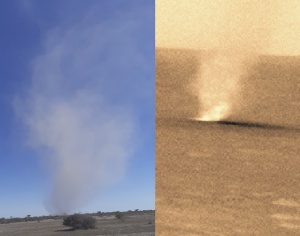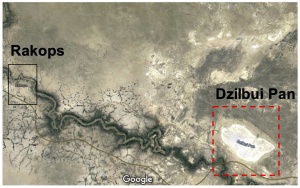Dust Devil Diary
From 29 September – 6 October 2021, researchers Daniel Toledo and Victor Apestigue (Instituto Nacional de Técnica Aeroespacial (INTA), Spain) were funded by the Europlanet 2024 Research Infrastructure (RI) Transnational Access (TA) programme to visit the Makgadikgadi Salt Pans in Botsawana. The trip was led by Fulvio Franchi (Botswana International University of Science and Technology (BIUST)) who is responsible for the Botswana Planetary Field Analogue for Europlanet 2024 RI. Ignacio Arruego, Javier Martinez-Oter and Felipe Serrano (INTA) also participated in the field trip. In this guest post, Daniel Toledo reports on the field trip.
The main goal of the field campaign in the Makgadikgadi Salts Pans was to study how dust is lifted into the air. For our investigation, we used the spare units of the Radiation and Dust Sensor (RDS) from the NASA Mars 2020 mission and the Sun Irradiance Sensor (SIS) from the ExoMars 2022 mission (see Figure 1), which are designed to study dust carried in the atmosphere of Mars by measuring how sunlight is scattered by the dust particles.
In addition to giving information about the properties of airbourne dust, these instruments are also sensitive to the presence of dust devils – swirling columns of sand and dust that are a common feature of desert areas on Mars and on Earth. RDS and SIS can detect the changes over time in the sky brightness produced by a dust devil, and this offers a unique opportunity for monitoring and studying such events during the Mars 2020 and ExoMars 2022 missions. However, to be able to characterise and interpret dust devil observations on Mars, we first need to understand how dust devils affect SIS and RDS signals by thorough testing and evaluation of the instruments in Mars-like conditions on Earth.


To achieve this goal, we planned a field campaign from 29 September to 6 October in the southern part of Makgadikgadi Salt Pans (see Figure 3), in the Pan near Mopipi town. This location is characterised by frequent dust devil events and conditions that promote the lifting of high levels of aerosols (dust and particles) into the atmosphere.
Each day of the campaign, we set up RDS and SIS at two different locations from sunrise to sunset, separated by about 25 m, along with:
- Two cameras to record panoramic videos during the campaign period.
- A Vaisala weather station to perform measurements of pressure, wind direction and intensity, temperature and relative humidity.
- A ZEN radiometer to measure how much light was absorbed by the dust at different wavelengths.
The objective of having the two main instruments at two different locations was observe the dust lifting events from different perspectives.
During the campaign, we observed a large number of dust devils (many more than 10) and dust lifting events produced by wind gusts (over 10). For each dust lifting, we recorded the dust devil distance, the size, duration and direction. To do this, we marked out concentric circles with radii of 25, 50, 75, 100, 125 and 150 m on the ground. This information along with the videos made by the cameras, helped us to establish the amount of dust lifted by the dust devil as well as their distances from the instruments. All the data collected for each event was key to establish the RDS and SIS capabilities for dust lifting characterisation on Mars.
The first two days of the campaign were characterised by high dust-loading conditions and frequent formations of dust lifting events produced by dust devils or wind gusts. During these two days, each dust lifting event registered by the cameras was also detected by RDS and SIS, with signals showing a sharp peak at the time when the event passed within the sensors field of view. Preliminary analysis suggests that we can infer from RDS and SIS signals the difference between dust lifting events produced by dust devils and those produced by wind gusts – an important result for the observations on Mars.

The third day of campaign had to be cancelled due to rain. This resulted in a lower dust-loading conditions in the following days, and thus the amount of dust lifted by vortices or wind gusts was smaller compared to the first two days.
Upon return to BIUST in Palapye on 6 October, we held a seminar for staff and students titled Atmospheric science on Mars: from Earth analogues to future planetary networks.
In summary, the campaign was a complete success. Our observations have demonstrated the capability of the RDS and SIS sensors to detect and characterise dust devils on Mars. The analysis of the signals along with the information acquired by the other instruments will allow us to quantitatively establish the sensors limit of detection. In addition, the rainy episode offered us the chance to study dust lifting events in different aerosol loading conditions.

20-EPN2-065: Characterizing dust lifting events using the ground-based Mars-2020-RDS and ExoMars-2022-SIS radiometers. This project has received funding from the European Union’s Horizon 2020 research and innovation programme under grant agreement No 871149.

